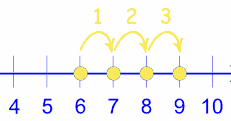Addition is ...
... bringing two or more numbers (or things) together to make a new total.
Here 1 ball is added
to 1 ball
to make 2 balls: | |  |
| Using Numerals it is: | | 1 + 1 = 2 |
| | | |
| And in words it is: | | "One plus one equals two" |
Example: When we add 2 and 3 we get 5.
We can write it like this:
2 + 3 = 5
Try It
Write this down, with the answer, using numerals:
You should get: 4 + 3 = 7
Swapping Places
Swapping the position of the numbers we are adding still gets the same result!
| 3 + 2 = 5 |  |
| ... also ... | |
| 2 + 3 = 5 |  |
More Examples:
5 + 1 = 1 + 5 = 6
7 + 11 = 11 + 7 = 18
4 + 100 = 100 + 4 = 104
Count From A Number Upwards
Example: 6 + 3

Think "6 ... 7, 8, 9"
Hint: start from the larger number.
Example: 2 + 6
2 + 6 is Harder: "2 ... 3, 4, 5, 6, 7, 8"
6 + 2 is Easier: "6 ... 7, 8"
So do 6 + 2 instead (you get the same answer).
Jump Strategy
We can also count by 2s or 10s, or make any "jumps" we want to help us solve a calculation.
Example: 4 + 12
Think "4 ... 14 ... 15, 16"
Adding Up To Ten
See if any numbers add to 10. They don't have to be next to each other.
Example: 7 + 8 + 3 + 2 + 5
7+3 is 10,
8+2 is another 10, which makes 20,
Plus 5 is 25
Do The Tens Last
Break big numbers into Tens and Units, add the Units, then add on the Tens.
Example: 14+5
Break the "14" into Tens and Units: 10 + 4
Add the Units: 4 + 5 = 9
Now add the Tens: 10 + 9 = 19
Think "4 plus 5 is 9, plus 10 is 19"
Another Example: 14 + 12
Break into Tens and Units: 10 + 4 + 10 + 2
Add the Units: 4 + 2 = 6
Now add on the Tens: 6 + 10 + 10 = 26
Aim for Ten
When a number is close to ten we can "borrow" from the other number so it reaches ten.
|
Example: 9 + 7
9 is only 1 away from 10
|
so take 1 from the 7: 9 + 1 + 6
and give it to the 9: 10 + 6 = 16
Think "9 plus 1 is 10 ... 7 less 1 is 6 ... together that is 16"
|
Example: 8 + 5
8+2=10, so lets take 2 from the 5: 8 + 2 + 3
and give it to the 8: 10 + 3 = 13
We can also move backwards to ten, by making the other number bigger as needed:
Example: 12 + 7
Reduce 12 by 2: 12 − 2 = 10
Increase 7 by 2: 7 + 2 = 9
12 + 7 = 10 + 9 = 19
Compensation Method
"Compensation" is where you round up a number (to make adding easier) and then take away the extra after you have added.
Example 19+16
It is easier to do 20 + 16 = 36
Then take away the extra 1 (that made 19 into 20) to get: 35
Example 395 + 126
It is easier to do 400 + 126 = 526
Then take away the extra 5 (that made 395 into 400) to get: 521
Double when the numbers are the same
Example 5 + 5 = 2 x 5 = 10
Double if the numbers are close, then fix
Example: 5 + 6 is nearly two 5s, but 6 is 1 bigger than 5, so:
5 + 6 = two 5s + 1 = 10 + 1 = 11
Example: 7 + 9 is like two 8s, but 7 is 1 smaller than 8, and 9 is 1 bigger than 8. So it is exactly two 8s because 1 smaller and 1 bigger cancel each other:
7 + 9 = "8 less 1" + "8 add 1" = two 8s = 16








Post a Comment